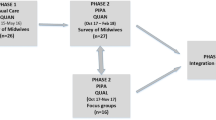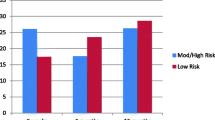Abstract
Recognition of high rates of mental health morbidity and mortality that affect women during the perinatal period has prompted the development of psychosocial risk assessment programs. Designed to identify women, at risk, during routine health checks and delivered by primary care health service providers, these fit within a primary prevention and early intervention strategic approach to the reduction of perinatal mental illness and reflect an integrated approach to perinatal health services delivery. This paper describes the development and use of the psychosocial risk assessment model (PRAM) at the Royal Hospital for Women in Sydney, Australia. Data is presented on 2,142 women who attended the Antenatal Midwives Clinic between 2002 and 2005. The PRAM guides primary care staff to quickly identify women experiencing emotional distress and/or psychosocial problems during pregnancy or postnatal checks. Measures used in pregnancy are the symptom-based Edinburgh Depression Scale and the psychosocial risk-based Antenatal Risk Questionnaire. In postnatal setting the Postnatal Risk Questionnaire is used. Scores can be used to compute a Psychosocial Risk Index (PRI) to guide individualized care planning, define needs for referral and classify groups for clinical and research purposes. Based on the PRI, among 2,142 women assessed in pregnancy 70.6% were classified as low/no risk (no interventions indicated currently), 24.1% as medium risk (in need of monitoring), and 5.3% as high risk (complex). The PRAM offers a conceptual framework, methods and measures for brief psychosocial assessment with clinical and research applications. Postpartum follow up studies of women assessed during pregnancy have commenced. Randomized controlled trials and cross-cultural studies are now indicated to strengthen the evidence base for the model.




Similar content being viewed by others
References
ACOG (2000) Psychosocial risk factors: perinatal screening and intervention. ACOG Educational Bulletin Number 255, November 1999. Int J Gynecol Obstet 69:1999
Adams RE, Bromet EJ, Panina N, Golovakha E, Goldgaber D, Gluzman S (2002) Stress and well-being in mothers of young children 11 years after the Chernobyl nuclear power plant accident. Psychol Med 32:143–156
Alder J, Fink N, Bitzer J, Hosli I, Holzgreve W (2007) Depression and anxiety during pregnancy: a risk factor for obstetric, fetal and neonatal outcome? A critical review of the literature. J Matern Fetal Med 20(3):189–209
Armstrong S, Small R (2007) Screening for postnatal depression: not a simple task. Aust N Z J Public Health 31(1):57–61
Austin M-P (2003) Psychosocial assessment and management of depression and anxiety in pregnancy: key aspects of antenatal care for general practice. Aust Fam Physician 32:119–126
Austin M-P, Lumley J (2002) Antenatal screening for women at-risk of postnatal depression. Acta Psychiatr Scand 106:1–8
Austin M-P, Priest SR (2005) Clinical issues in perinatal mental health: new developments in the detection and treatment of perinatal mood and anxiety disorders. Acta Psychiatr Scand 112:97–104
Austin MP, Hadzi-Pavlovic D, Saint K, Parker G (2005) Antenatal screening for the prediction of postnatal depression: validation of a psychosocial Pregnancy Risk Questionnaire. Acta Psychiatr Scand 112(4):310–317
Austin MP, Kildea S, Sullivan E (2007) Maternal mortality and psychiatric morbidity in the perinatal period: challenges and opportunities for prevention in the Australian setting. Med J Aust 186:364–367
Austin M-P, Frilingos M, Lumley J, Hadzi-Pavlovic D, Roncolato W, Acland S, Saint K, Segal N, Parker G (2008a) Brief antenatal cognitive behaviour therapy group intervention for the prevention of postnatal depression and anxiety: a randomized controlled trial. J Affect Disord 105(1–3):35–44
Austin M-P, Priest SR, Sullivan E (2008b). Antenatal psychosocial assessment for reducing perinatal mental health morbidity. Cochrane Database Syst Rev 2005, Issue 1. Art No.: CD005124. doi:10.1002/14651858.CD005124
Barnett B, Glossop P, Matthey S, Stewart H (2005) Screening in the context of integrated perinatal care. Chapter 6. In: Henshaw C, Elliot S (eds) Screening for perinatal depression. Jessica Kingsley, London, pp 68–82
Beck CT, Gable RK (2001) Comparative analysis of the postpartum depression screening scale with two other depression instruments. Nurs Res 50(4):242–250
Beck AT, Ward CH, Mendelson M, Mock J, Erbaugh J (1961) An inventory for measuring depression. Arch Gen Psychiatry 4:561–571
Beck CT, Records K, Rice M (2006) Further development of the postpartum depression predictors inventory-revised. J Obstet Gynecol Neonatal Nurs 35(6):735–745
Bernazzini O, Marks MN, Bifulco A, Siddle K, Asten P, Conroy S (2005) Assessing psychosocial risk in pregnant/postpartum women using the contextual assessment of maternity experience (CAME). Soc Psychiatry Psychiatr Epidemiol 40:49–508
Blackmore ER, Carroll J, Reid A, Biringer A, Glazier RH, Midmer D, Permaul JA, Stewart DE (2006) The use of the antenatal psychosocial health assessment (ALPHA) tool in the detection of psychosocial risk factors for postpartum depression: a randomised controlled trial. JOGC 28(10):873–878
Buist A, Condon J, Brooks J, Speelman C, Milgrom J, Hayes B, Ellwood D, Barnett B, Kowalenko N, Matthey S, Austin M-P, Bilszta J (2006) Acceptability of routine screening for perinatal depression. J Affect Disord 93:233–237
Buist A, Ellwood D, Brooks J, Milgrom J, Hayes BA, Sved-Williams A, Barnett B, Karatas J, Bilszta J (2007) National program for depression associated with childbirth: the Australian experience. Best Pract Res Clin Obstet Gynaecol 21(2):193–206
Carroll JC, Reid AJ, Biringer A, Midmer D, Glazier RH, Wilson L, Permaul JA, Pugh P, Chalmers B, Seddon F, Stewart DE (2005) Effectiveness of the antenatal psychosocial health assessment (ALPHA) form in detecting psychosocial concerns: a randomised controlled trial. CMAJ 173(3):253–259
Cox J, Holden J (2003) Perinatal mental health: a guide to the Edinburgh Postnatal Depression Scale (EPDS). Gaskell, London
Cox JL, Holden JM, Sagovsky R (1987) Detection of postnatal depression. Development of the 10-item Edinburgh Postnatal Depression Scale. Br J Psychiatry 150:782–786
Drewett R, Blair P, Emmett P, Emond A, The ALSPAC Study Team (2004) Failure to thrive in the term and preterm infants of mothers depressed in the postnatal period: a population-based birth cohort study. J Child Psychol Psychiatry 45(2):359–366
Gavin NI, Gaynes BN, Lohr KN, Meltzer-Brody S, Gartlehner G, Swinson T (2005) Perinatal depression: a systematic review of prevalence and incidence. Obstet Gynecol 106(5–1):1071–1083
Glover V, O’Connor TG (2002) Effects of antenatal stress and anxiety: implications for development and psychiatry. Br J Psychiatry 180:389–391
Gunn J, Hegarty K, Nagle C, Forster D, Brown S, Lumley J (2006) Putting woman-centred care into practice: a new (ANEW) approach to psychosocial risk assessment during pregnancy. Birth 33:1
Howard LM, Goss C, Leese M, Appleby L, Thornicroft G (2005) The psychosocial outcome of pregnancy in women with psychotic disorders. Evid-Based Mental Health 8(2):33
Mares S, Newman L, Warren B (2005) Clinical skills in infant mental health. ACER, Australia
Matthey S, Phillips J, White T, Glossop P, Hopper U, Panasetis P, Petridis A, Larkin M, Barnett B (2004) Routine psychosocial assessment of women in the antenatal period: frequency of risk factors and implications for clinical services. Archives of Women’s Mental Health 7:223–229
Milgrom J, Gemmill AW, Biltszta JL, Hayes B, Barnett B, Brooks J, Ericksen J, Ellwood D, Buist A (2008) Antenatal risk factors for postnatal depression: a large prospective study. J Affect Dis 108:147–157
Murray D, Cox JL (1990) Screening for depression during pregnancy with the Edinburgh Depression Scale (EPDS). J Reprod Infant Psychol 8(2):99–107
Murray L, Cooper P (eds) (1997) Postpartum depression and child development. Guildford, London
Murray L, Woolgar M, Murray J, Cooper P (2003) Self-exclusion from health care in women at high risk of postpartum depression. J Public Health Med 25(2):131–137
NICE (2006) Antenatal and postnatal mental health: clinical management and service guidance. http://www.nice.org.uk.CG45
Oates M (2003) Perinatal psychiatric disorders: a leading cause of maternal morbidity and mortality. Br Med Bull 67:219–229
Orr ST, Blazer DG, James SA, Reiter J (2007) Depressive symptoms and indicators of maternal health status during pregnancy. J Women’s Health 16(4):535–542
Priest SR (2006) Midwife-led antenatal psychosocial screening in a primary care obstetric setting: A case study. Unpublished Master of Public Health thesis, University of New South Wales School of Public Health and Community Medicine
Priest SR, Henderson J, Evans SF, Hagan R (2003) Stress debriefing after childbirth: a randomised controlled trial. Med J Aust 178:542–545
Priest SR, Barnett B (2008) Perinatal anxiety and depression: issues, outcomes and interventions chapter in Sued Williams A and Cowling V (eds). Infants of parents with mental illness: developmental, clinical, cultural and personal perspectives. Australian Academic Press
Rahman A (2005) Maternal depression and child health: the need for holistic health policies in developing countries. Harvard Health Policy Rev 6:70–80
Robertson E, Grace S, Wallington T, Stewart D (2004) Antenatal risk factors for postpartum depression: a synthesis of recent literature. Gen Hosp Psychiatry 26(4):289–295
Ross LE, Sellers EM, Evans SE, Gilbert Romach MK (2004) Mood changes during pregnancy and the postpartum period development of a biopsychosocial model. Acta Psychiatr Scand 109(6):457–466
Webster J, Pritchard MA, Creedy D, East C (2003) A simplified predictive index for the detection of women at risk for postnatal depression. Birth 30:101–110
Webster J, Hall L, Somville T, Schneider P, Turnbull R, Smith P (2006) Prospective testing of the Brisbane Postnatal Depression Index. Birth 33(1):56–63
Acknowledgement
This work was supported in part by funds from Beyondblue: The National Depression Initiative under the National Postnatal Depression Program—New South Wales and Royal Hospital for Women (NSW) sections 2002–2005.
Sabine Merz, Research Assistant
Nicole Reilly, Editing assistance
Clinical Staff at RHW
Nursing Administration at RHW especially Helen Jarman
All participants who gave time
Author information
Authors and Affiliations
Corresponding author
Appendix A Antenatal Risk Questionnaire (ANRQ)
Appendix A Antenatal Risk Questionnaire (ANRQ)

Rights and permissions
About this article
Cite this article
Priest, S.R., Austin, MP., Barnett, B.B. et al. A psychosocial risk assessment model (PRAM) for use with pregnant and postpartum women in primary care settings. Arch Womens Ment Health 11, 307–317 (2008). https://doi.org/10.1007/s00737-008-0028-3
Received:
Accepted:
Published:
Issue Date:
DOI: https://doi.org/10.1007/s00737-008-0028-3




